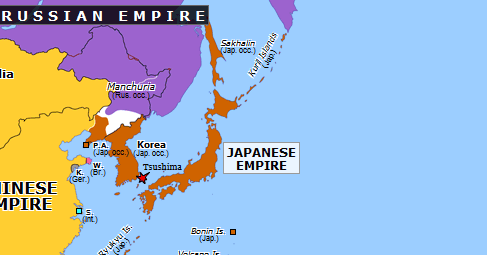The Russo-Japanese War
Part 1: Initial Developments Japan’s victory over China in the First Sino-Japanese War was an elevation of one country in world stature and prestige over another. The same was true of the Russo-Japanese War. In both cases, Japan emerged the stronger. 
After American Commodore Matthew Perry convinced Japan to open its borders and trade with the result of the world, Japan embarked on a strategy of industrialization and modernization that stretched across the spectrum of the country, especially in its military might, which Japan demonstrated vividly in its demolition of a larger Chinese force in 1894 and 1895. One of the provisions of the treaty that ended that war was the cession of the Liaodong Peninsula, with its strategic Port Arthur, from China to Japan. Soon after, however, international pressure from France, Germany, and Russia convinced Japan to hand back the Liaodong Peninsula. Russia had a vested interest in seeing the Liaodong Peninsula return to Chinese control, not just because it was within China’s traditional borders. Russia soon had a naval base at Port Arthur, on that peninsula, satisfying a desire long held by Russia’s leaders of having a warm-water port on the Pacific Ocean that was not subject to winter freezes, as was Russia’s one existing Pacific port, at Vladivostok, in the north. In fact, Russia had, in 1900, occupied the Chinese area of Manchuria, as a result of the international fighting that resulted from the Boxer Rebellion. Thus, Russia was in control of an important port and an important chunk of land that had both been in China’s possession during the war between China and Japan.
Russia had recently completed the Trans-Siberian Railroad, linking west to east. Having rail transport as an option would give the military more flexibility in terms of shipping troops from west to east more quickly if need be. Russia was also constructing a railway through Manchuria and a strategic area called Mukden to Port Arthur. This was to be the South Manchurian Railroad. Russia had already sent nearly 200,000 soldiers to Manchuria during the Boxer Rebellion; after that rebellion was quelled, about half of those troops remained. As the 20th Century dawned, Japan and Russia came increasingly into competition in terms of influence and territory. Japan offered to recognize Russia’s claim to Port Arthur, which was technically still Chinese territory, in exchange for Russia’s recognizing that Japan had nominal control over Korea. Russia refused and instead requested a buffer zone between the two countries, north of the 39th parallel, which would have effectively removed Japanese control of the large city of Pyongyang. Korea was still an independent country at this point, but it was still surrounded by large an ambitious neighbors who were unwilling to ignore the Korean Peninsula as a battleground, even though Korea wasn’t one of the combatants. |
|



 Port Arthur was on the Liaodong Peninsula, which stretched out into the water surrounding northeast China, particularly Manchuria. Russian control of this port gave Russia command (or at least knowledge) of the shipping that sailed through on its way to Beijing, China’s capital city.
Port Arthur was on the Liaodong Peninsula, which stretched out into the water surrounding northeast China, particularly Manchuria. Russian control of this port gave Russia command (or at least knowledge) of the shipping that sailed through on its way to Beijing, China’s capital city.
